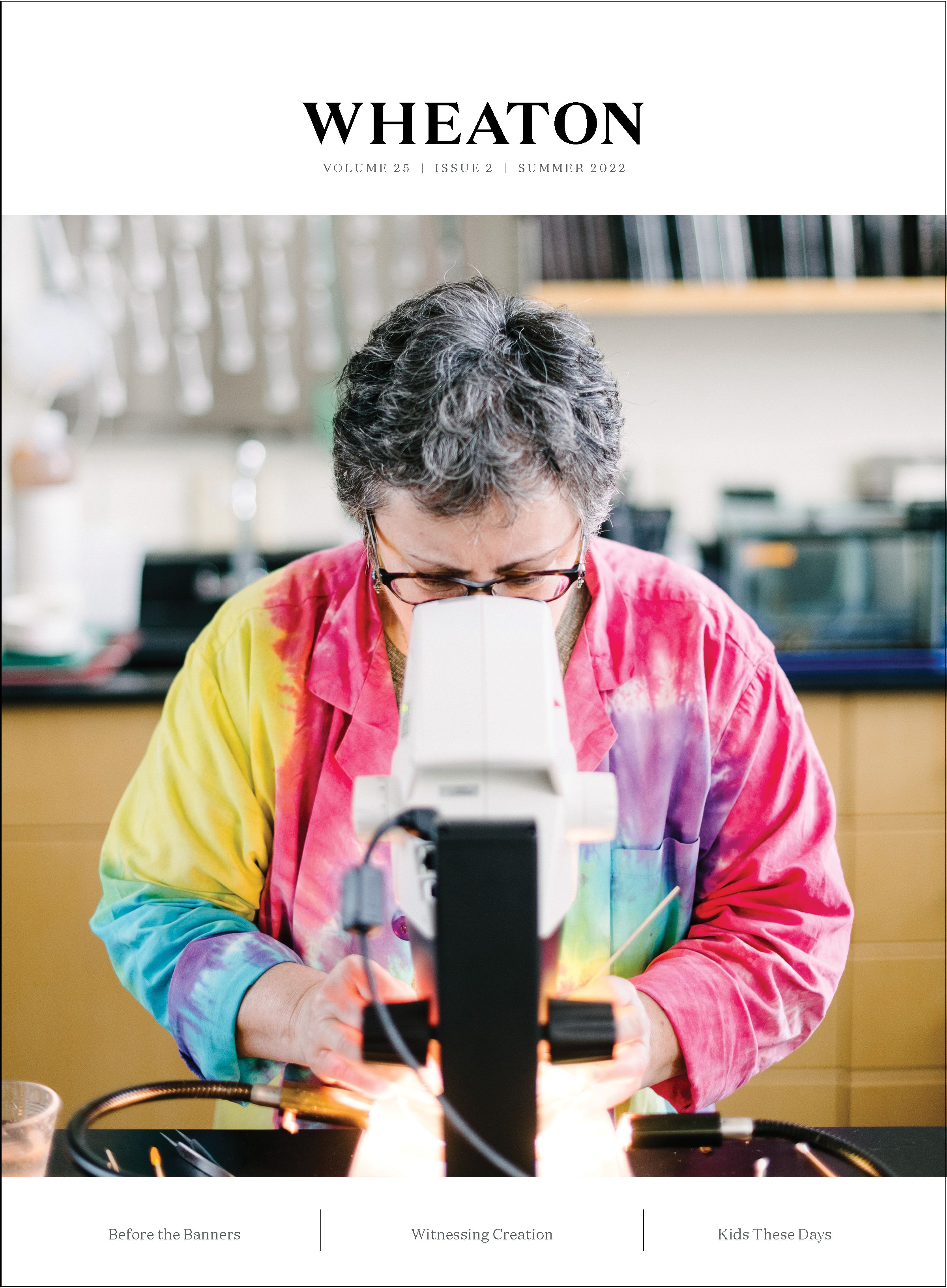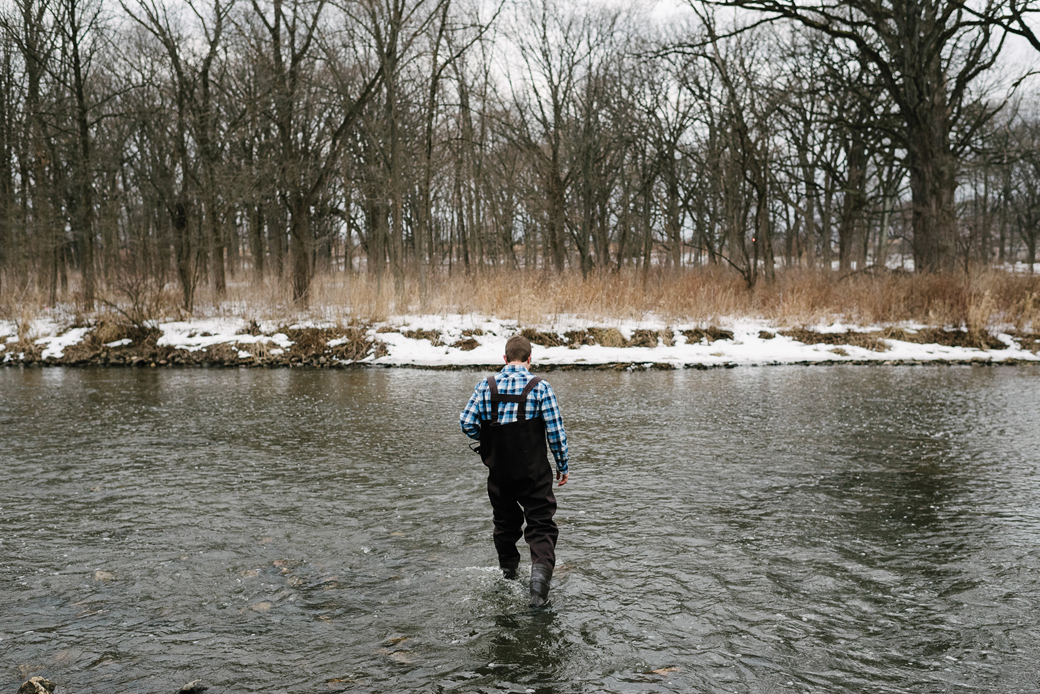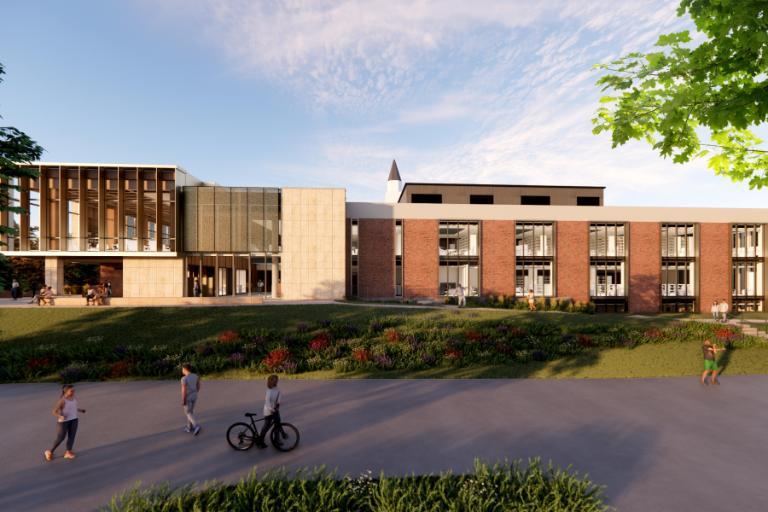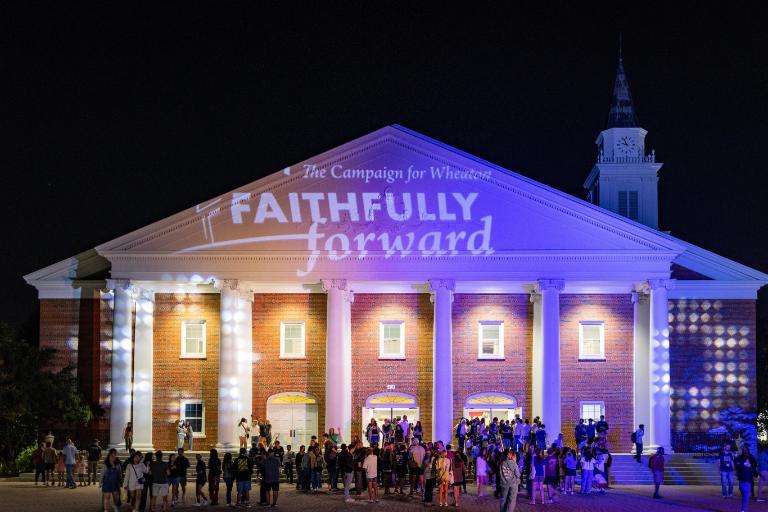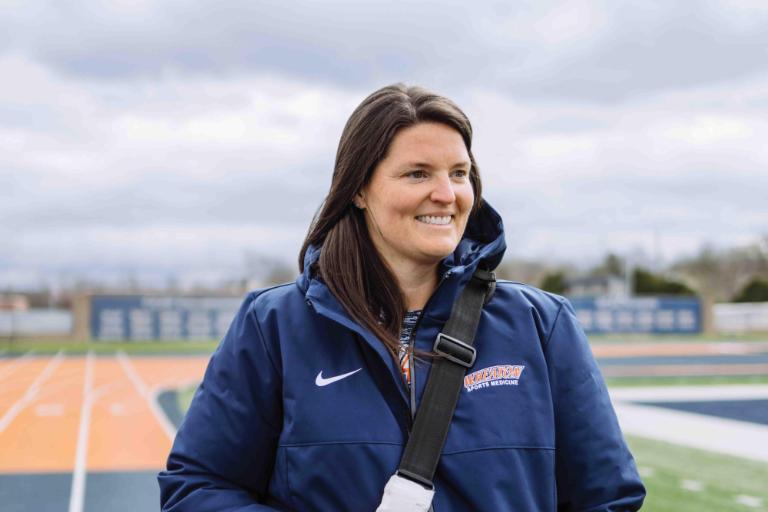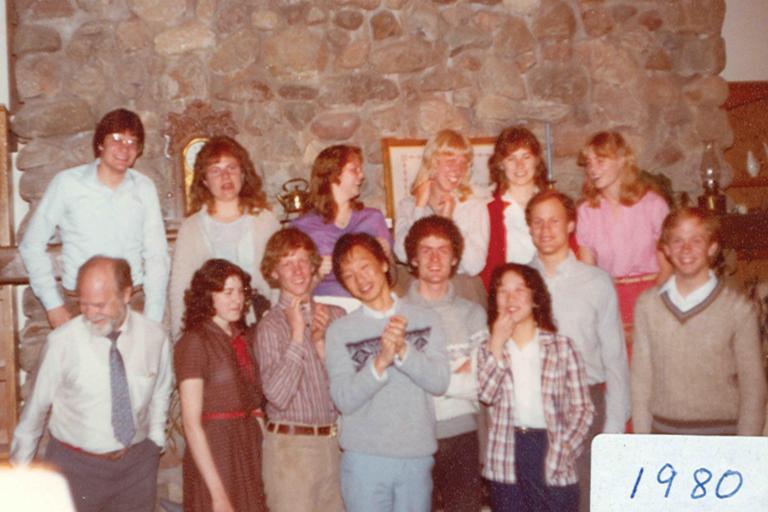Witnessing Creation
Twelve Wheaton Natural Scientists Share Their Research
Words: Liuan Chen Huska ’09
Photos: Tony Hughes, Josh and Alexa Adams
Wonder. Intimate worship. Witnessing God’s care and beauty. Partnering with God to restore his world. These are some of the ways that Wheaton professors in the natural sciences describe their research. Spanning various disciplines and continents, from vast aurora lights to minuscule molecules, each scientist profiled uncovers the intricate ways our world has been made. Together, their work becomes a testament to a wonderfully creative God and a call to better understand him through scientific study.
Dr. Nadine Rorem
“Life cycle of freshwater jellyfish Craspedacusta sowerbii”
Biological and Health Sciences
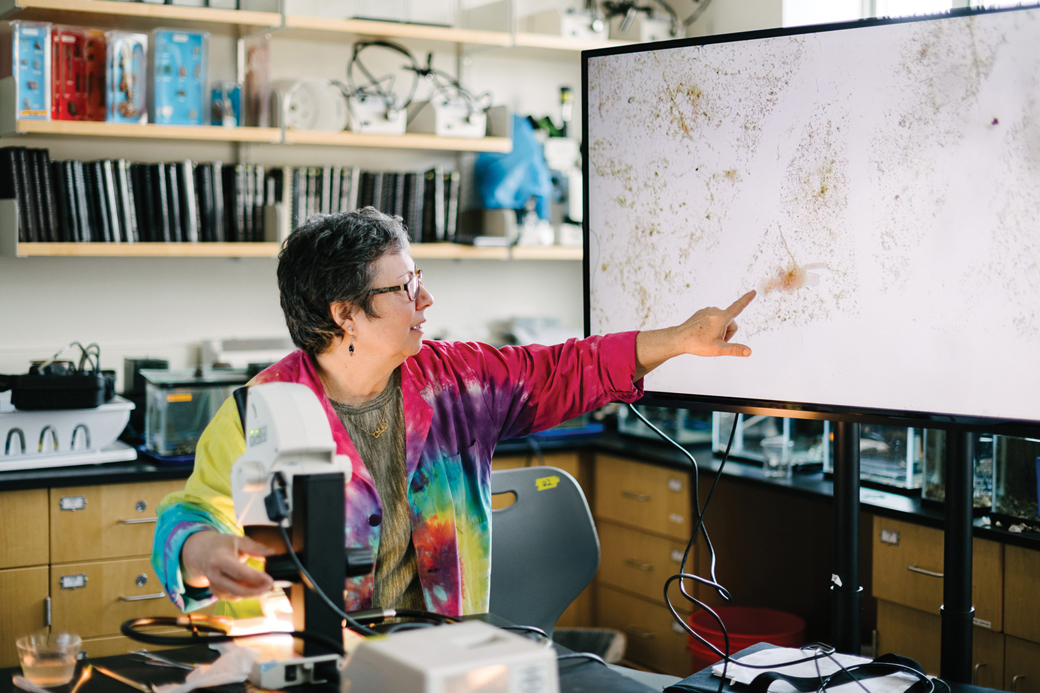
Dr. Nadine Rorem examines microorganisms in the lab
Years ago, when Nadine Rorem was becoming certified in scuba diving, she swam through what felt like a snowstorm underwater. She was among a swarm of freshwater jellyfish, Craspedacusta sowerbii: white, each about the size of a quarter in mature medusa stage. Dr. Rorem recently received an Illinois-Indiana Sea Grant to better understand their life cycle.
Her research builds on earlier work with another invasive aquatic organism, Cordylophora caspia. Invasive aquatic species can affect food chains and potentially disrupt human food sources such as fisheries. Through her work on both these species, Dr. Rorem studies the effects of increasing temperatures and water levels, which shift the delicate balance of aquatic ecosystems.
Dr. Scott Ickes
“Workplace policies’ effects on breastfeeding mothers in Kenya”
Biological and Health Sciences
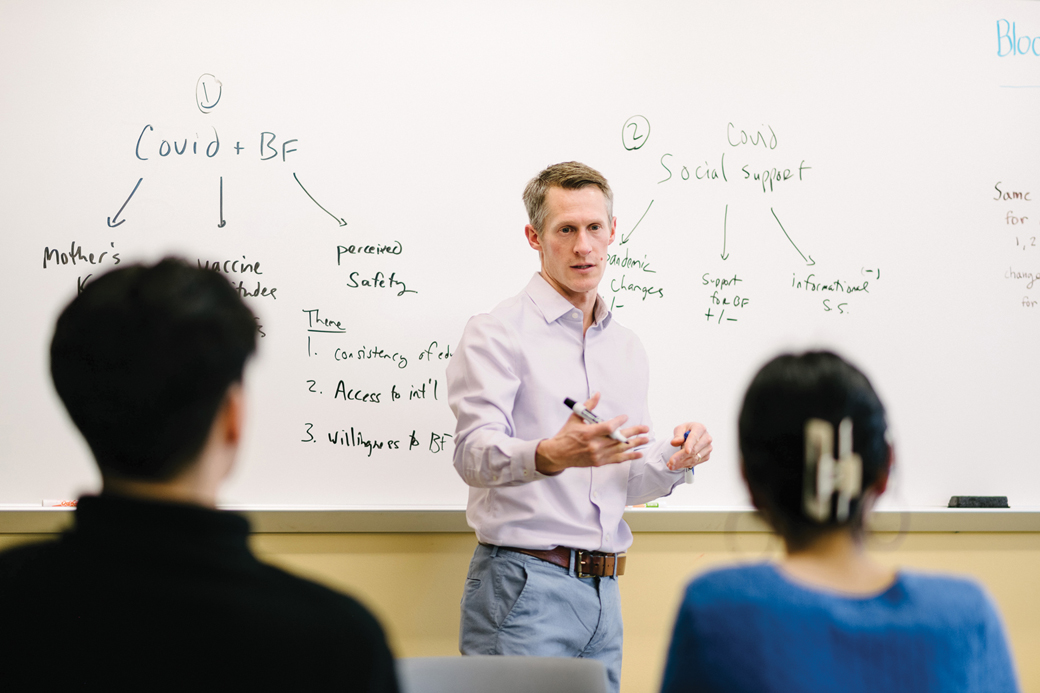
Dr. Scott Ickes presents a seminar lecture on the social impacts of COVID-19
Nutrition epidemiologist Scott Ickes’s longstanding interest in maternal and child nutrition has led in recent years to research on breastfeeding mothers in Kenya. The East African country is known as one of the leaders in policies that protect breastfeeding. However, policy creation is not the same as implementation, Dr. Ickes said.
In Naivasha, Kenya, Dr. Ickes and his team study the factors influencing whether working mothers exclusively breastfeed for the first six months of their children’s infancy. He found that while there is strong policy mandating lactation support at work, there are some mismatches with mothers’ needs. His research has already shaped local health center offerings for new mothers, while spurring employers to consider better workplace support for mothers.
Dr. Andrew Luhmann ’06
“Mapping underground caves in Florida and the effects of sequestering carbon underground”
Earth and Environmental Science
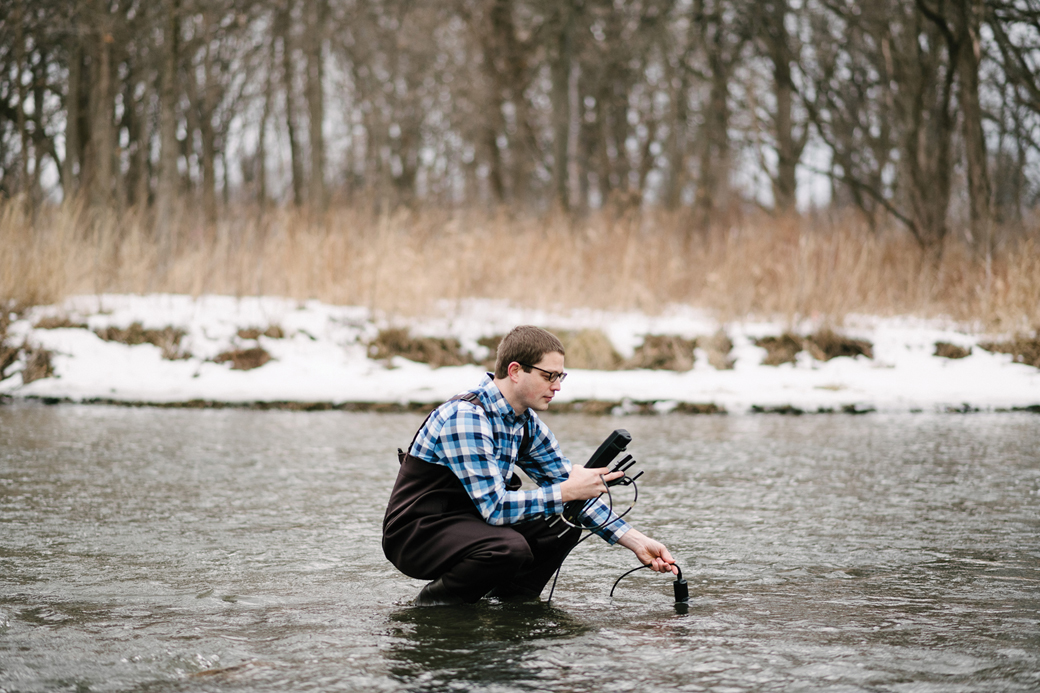
Dr. Andrew Luhmann studies a wintry river in Illinois
The Santa Fe River in Florida sinks into and reemerges from a karst aquifer, where rock dissolves to create caves, springs, and sinkholes. Hydrogeologist Andrew Luhmann ’06 and his team have been monitoring how changes at the land surface reflect water levels and other characteristics underground. He and several Wheaton students are also working to create an interactive traveling museum exhibit that models how water flow beneath the ground surface affects seismometer signals.
In New Mexico, Dr. Luhmann also advises laboratory experimental work on two geologic carbon sequestration projects to assess changes from injecting carbon dioxide underground. Carbon sequestration is one prong, he said, in the larger effort to mitigate climate change.
Dr. Kathryn Maneiro
“Unraveling the story of early earth through rock dating”
Earth and Environmental Science
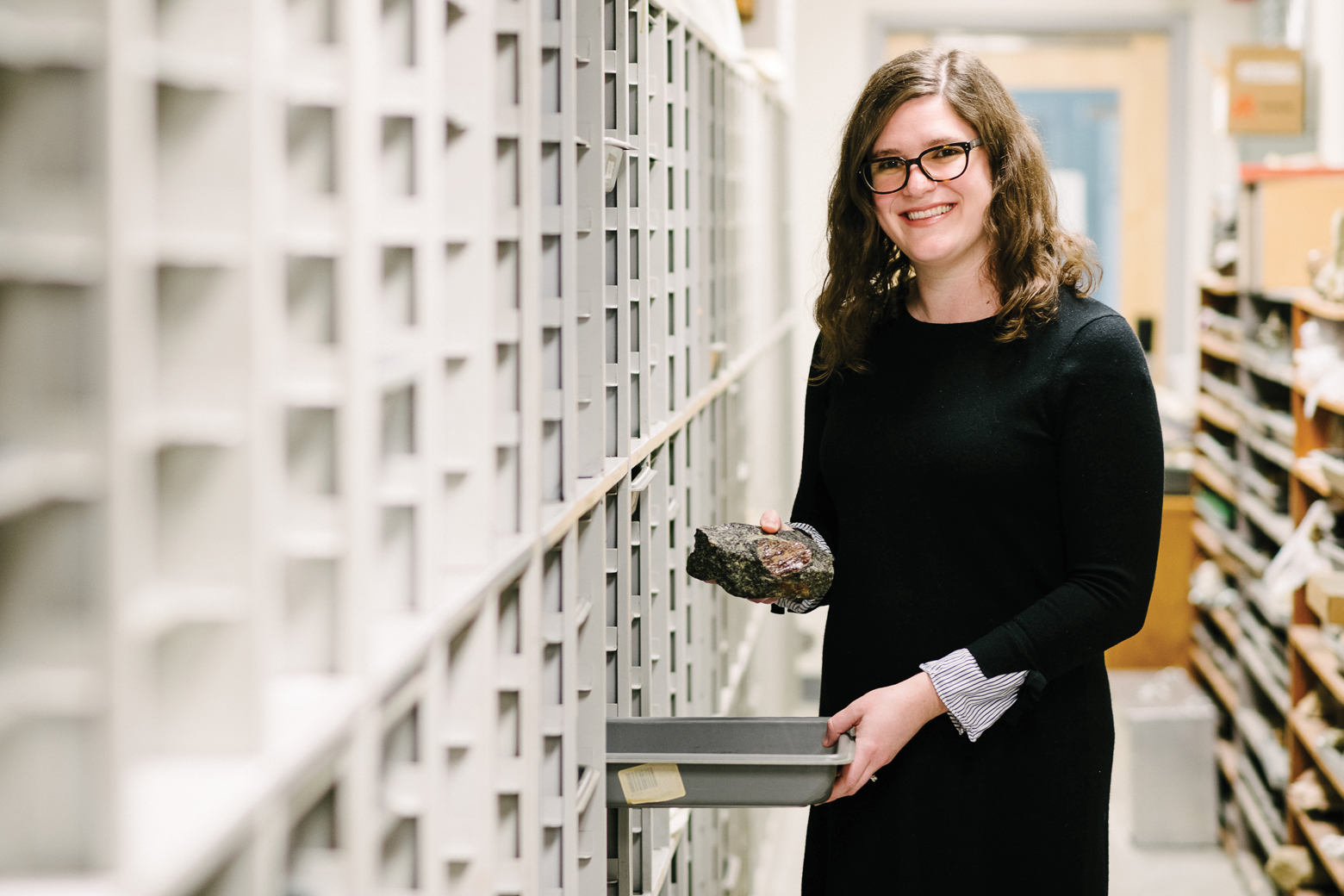
Dr. Kathryn Maneiro browses Wheaton’s geology collection
You might find geologist Kathryn Maneiro out collecting rocks, but more often she works in a lab, dissolving some of the world’s oldest rocks to isolate elements that indicate the rock’s age based on radioactive half-lives. Dr. Maneiro has dated the second-oldest piece of garnet in the world—which is over 3 billion years old.
In spring 2023, Dr. Maneiro will spend a semester in a clean lab facility in South Carolina dating garnet in ancient rocks from the Barberton Granite-Greenstone Belt in South Africa. She relishes the element of the unknown in her research, as well as understanding on a deeper level God’s role in establishing and caring for the earth where we live and thrive today.
Dr. Jovanka (Vanya) Tepavčević
“Symbiosis between bacteria Vibrio fischeri and Hawaiian bobtail squid”
Biological and Health Sciences

Dr. Jovanka (Vanya) Tepavčević inspects samples from her research
For the Hawaiian bobtail squid to survive in the shallow waters around Hawaii, it depends on a particular microbe known as Vibrio fischeri to colonize it and produce light, which counterilluminates the squid’s shadow cast on a moonlit night and makes it invisible to predators. Microbiologist Jovanka Tepavčević studies the various molecular regulatory mechanisms that determine whether the bacteria will engage in further symbiosis with the squid.
Learning more about this simple form of symbiosis, Dr. Tepavčević said, sheds light on the massive complexity that exists in humans, who depend on hundreds of thousands of microbes in the gut, skin, and other areas. She describes her work as an intimate worship experience: “I get to see what is usually invisible to us and understand God’s character and the care with which all of these things were made.”
Dr. Kristen Page
“Ecological transmission and control of raccoon roundworms”
Biological and Health Sciences
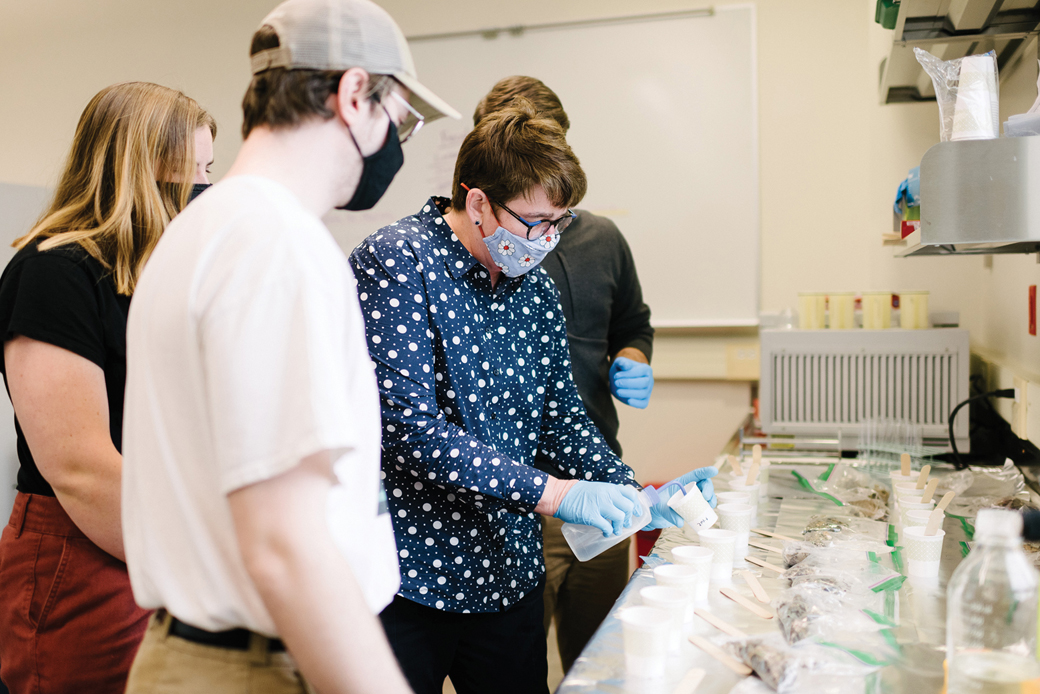
Dr. Kristen Page provides a demonstration in the biology lab
The roundworm parasite of raccoons (Baylisascaris procyonis) can infect small animals like mice, woodrats, squirrels, and other wildlife in its larval form, and the larval infections are also dangerous for humans who come in contact with raccoon droppings. Parasite eggs in the droppings can hatch into larvae and move through the bloodstream, causing brain damage. Ecologist Kristen Page studies ways to reduce the spread of this parasite.
She and her team are also currently studying how the foraging habits of raccoons affect their likelihood of getting infected by the parasite. How humans transform landscapes, she said, affects how diseases are transmitted. “Caring for creation is part of our call to love our neighbor,” she said.
Dr. Nathaniel Thom
“How exercise and attention training affect resilience”
Biological and Health Sciences
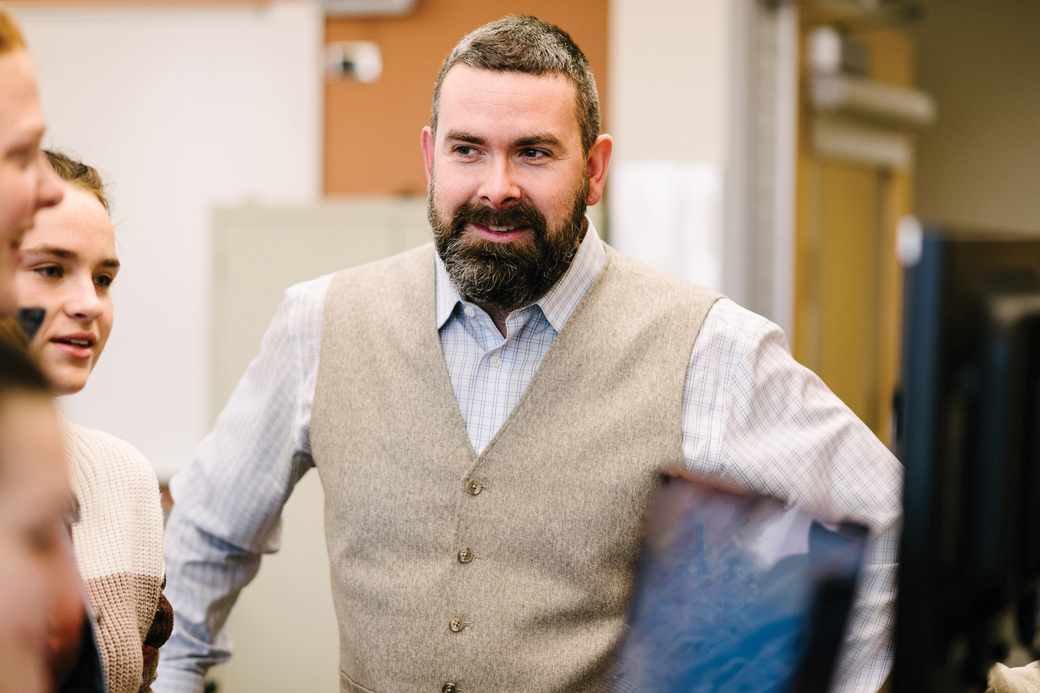
Dr. Nathaniel Thom engages students in classroom discussion
Is resilience learned or innate? Health neuroscientist Nathaniel Thom has asked this question in various ways through studying Marines, Navy SEALs, adventure racers, and now missionaries. He and his colleagues have found that increased body awareness and emotion regulation improve performance under stress.
Now, Dr. Thom is studying ways to promote resilience in missionaries before, during, and after their time on the field. His work includes monitoring how regular exercise affects missionaries’ physiological and brain imaging data. He is excited about the neuroscience program offered at Wheaton, which puts the College at the forefront of integrating body, mind, and spirit.
Dr. Allison Ruark
“Supporting healthy couple relationships as a disease prevention strategy”
Biological and Health Sciences
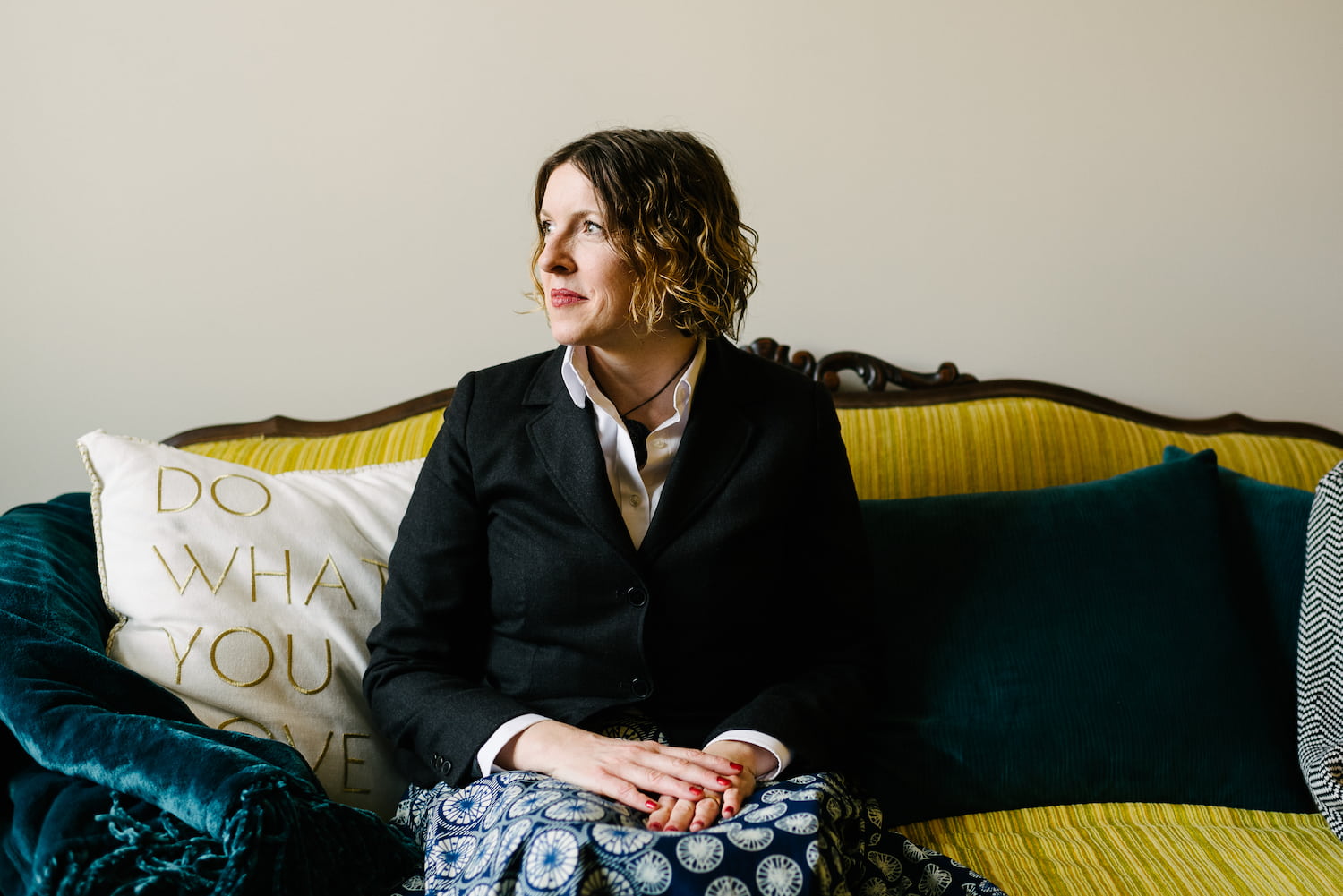
Dr. Allison Ruark contemplates in her office space
To prevent HIV infections in Africa, social epidemiologist Dr. Allison Ruark studies a factor many wouldn’t think to consider—couple relationship quality. She asks, “What kind of couple relationship needs to exist for mutual fidelity to even be an option?” Dr. Ruark and a colleague developed an assessment for couple sexual satisfaction sensitive to African cultural contexts. She also consults with nonprofit aid groups, such as Catholic Relief Services and World Relief, to measure and strengthen the effectiveness of family interventions.
The gospel has relevance, Dr. Ruark said, not just for individuals but for societies. “How do we restore societies back to ways that meet people’s needs so we have the conditions in which people can choose to get married and form stable families?”
Dr. Jim Schroeder ’09
“Electrons surfing Alfvén waves to cause aurora lights”
Physics
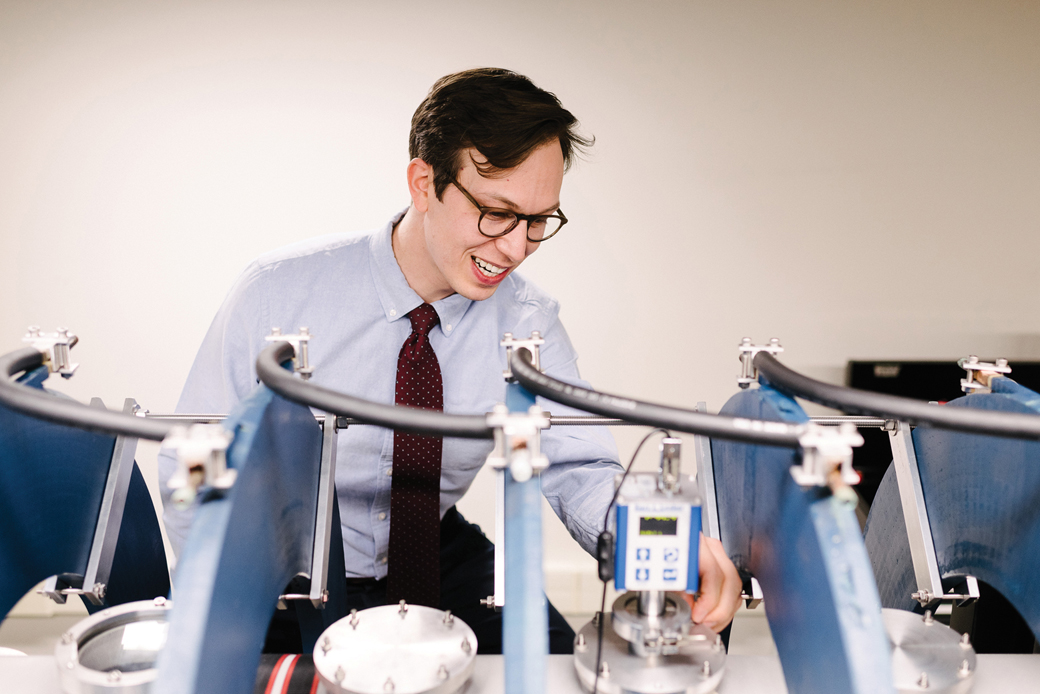
Dr. Jim Schroeder adjusts equipment in the physics lab
Jim Schroeder ’09 recalls the first time he saw evidence in the lab confirming his theory on the cause of distinct bands within aurora lights. “It was a still, quiet voice moment,” Schroeder said. “I got to be one of the first people to see that aspect of creation, which is really cool.”
For decades, physicists have wondered how the northern or southern lights are affected by Alfvén waves, a type of wave caused when solar winds interact with earth’s magnetic field. Just recently, Dr. Schroeder discovered through experiments a process he describes as surfing—electrons going at the right speed are picked up by an Alfvén wave and accelerate, eventually giving off the photons that create the spectacular bands of light we see in the skies.
Dr. Ray Lewis
“Conditions for kelp reproduction and thriving”
Biological and Health Sciences

Dr. Ray Lewis uses one of Wheaton’s many microscopes
Growing up in northern California, Ray Lewis became interested in marine biology through harvesting abalone with his family along the Sonoma County coastline.
Today, Dr. Lewis is an expert on kelp, large brown algae which form underwater forests. In the lab, Dr. Lewis manipulates salinity, iron levels, and other growing conditions to understand how kelp thrive and reproduce at different stages. Kelp are used in many cultures as food as well as for various industrial processes. Most importantly, said Dr. Lewis, they are “ecosystem engineers,” thriving in cool, nutrient-rich waters around the world and forming both physical habitat and the base of food chain in nearshore ocean communities.
Drs. Lisa and Dan Burden
“Understanding how alpha-hemolysin protein pores open and close”
Chemistry
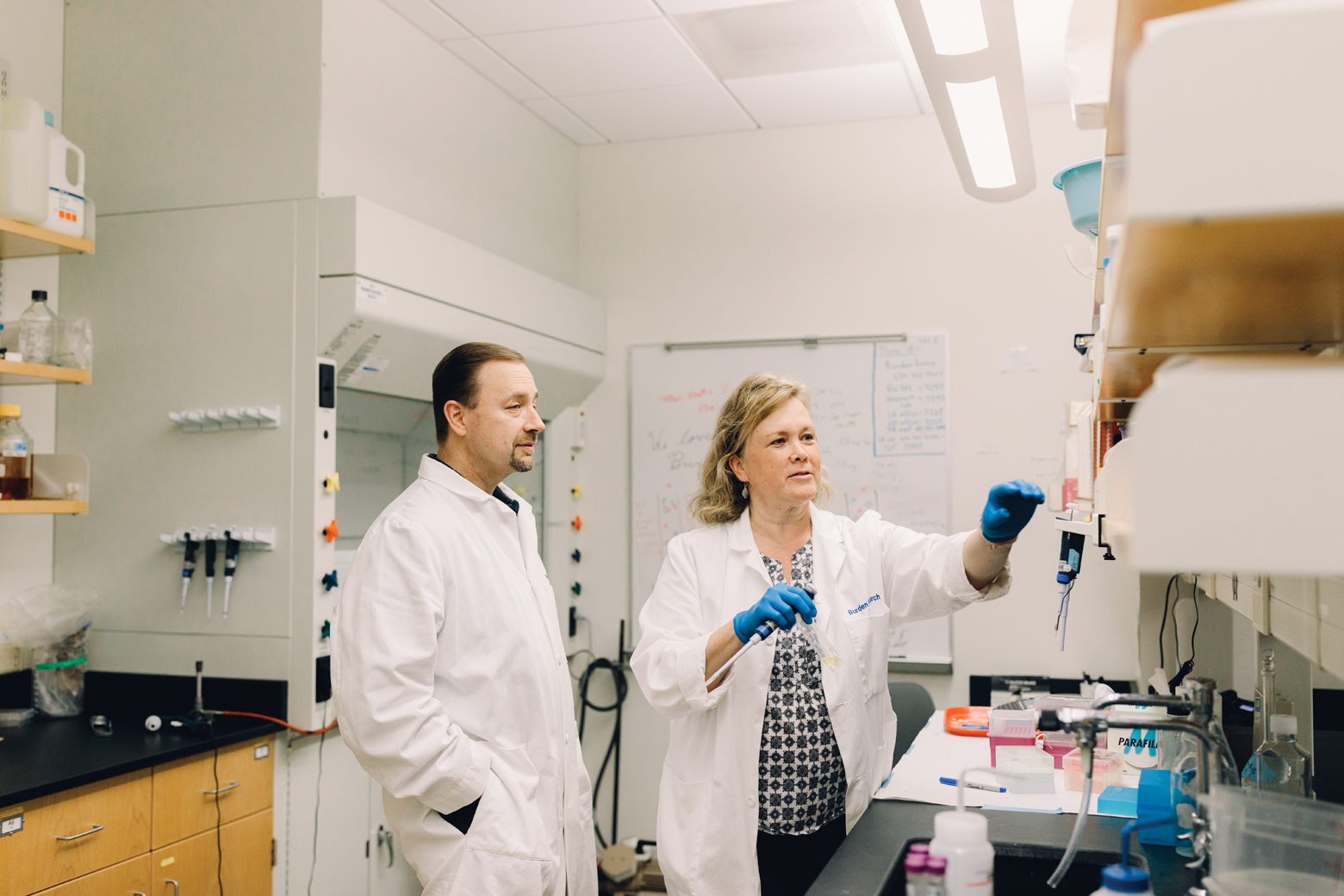
Drs. Lisa and Dan Burden discuss methods in the chemistry lab
Many are familiar with Staphylococcus aureus bacteria for the dangerous infections they cause. Fewer know that they produce a protein which could be used beneficially. Husband and wife team Lisa and Dan Burden have made understanding the protein, alpha-hemolysin, their life’s work.
Holding up a bumpy model about the size of a spreadout hand, Dr. Lisa Burden describes it. “Seven distinct molecules come together to form this beautiful pore,” she said. The Burdens are experimenting with ways to trigger the pore to open and close with various molecular tags. Creating pores that only open in certain conditions could allow for delivery of toxic drugs, such as chemotherapies, to limited areas instead of affecting the whole body.
